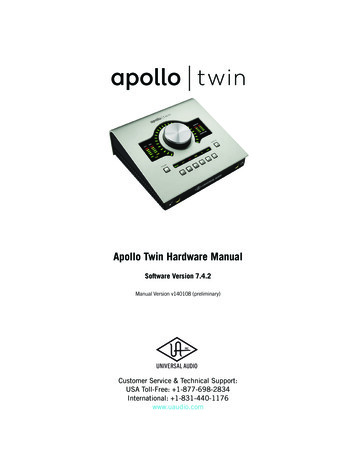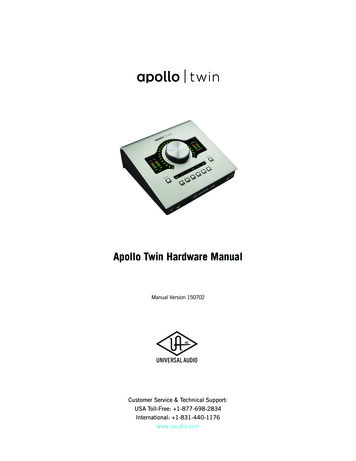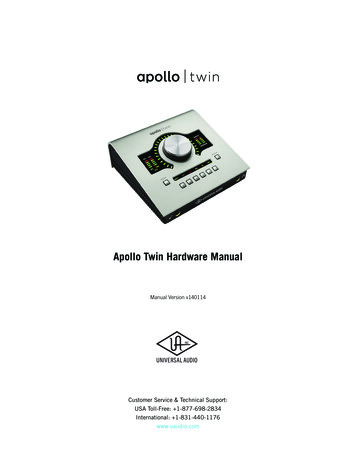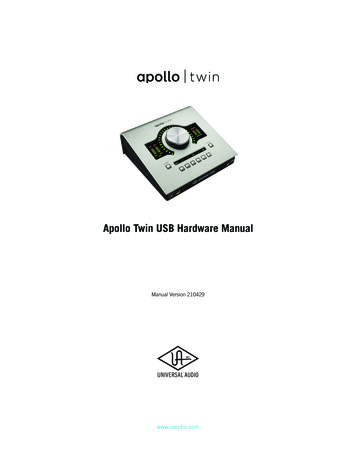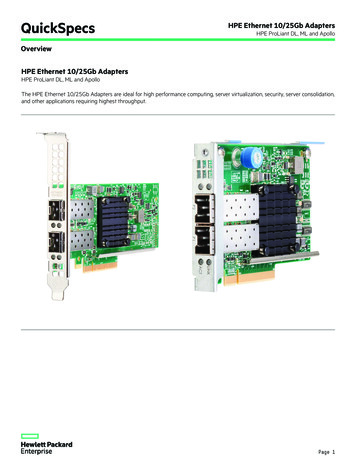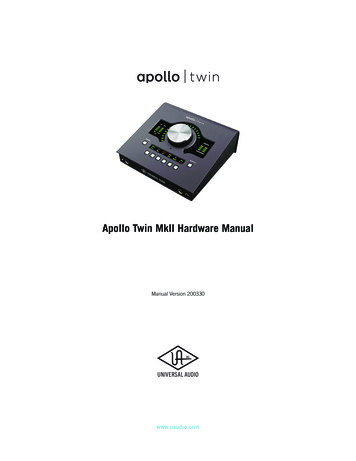
Transcription
Thunderbolt 3 Audio InterfaceApollo x8 Hardware ManualManual Version 210429www.uaudio.com
A Letter from Bill Putnam Jr.Thank you for choosing this Apollo X Series audio interface to become a part of yourstudio. We know that any new piece of gear requires an investment of time and money —and our goal is to make your investment pay off.Universal Audio interfaces like Apollo X exemplify a commitment to craftsmanship thatwe’ve forged over the past 60 years — from our original founding in the 1950s by myfather, Bill Putnam Sr., to our current mission combining the best of both classic analogand modern digital audio technologies.Starting with its ultra high-quality I/O and superior A/D and D/A conversion, Apollo Xis designed to set new benchmarks in sonic performance. Breakthrough fidelity is justthe beginning, however, as Apollo X’s onboard HEXA Core processing lets you power thefull range of UAD plug-ins, including classic mic preamps, EQs, dynamics processors,reverbs, guitar amps, and much more. With more than 100 acclaimed UAD plug-ins atyour fingertips, the sonic choices are limitless.At UA, we are dedicated to the idea that technology should serve the creative process,inspiring our customers to go further. These are the ideals my father embodied with hisclassic designs, and we like to think this spirit lives on today in products like Apollo X.Please feel free to reach out to us via our website www.uaudio.com, and via our socialmedia channels. We look forward to hearing from you, and thank you once again forchoosing Universal Audio.Sincerely,Bill Putnam Jr.Apollo x8 Hardware Manual2Welcome
Table Of ContentsTip: Click any section or page numberto jump directly to that page.A Letter from Bill Putnam Jr. 2Introduction. 4Apollo x8 Thunderbolt 3 Audio Interface. 4Apollo x8 Features. 7Apollo x8 Documentation Overview. 10Additional Resources. 11Front Panel. 12Rear Panel. 24Digital I/O. 25Analog I/O . 28Interconnections. 31Installation Notes. 31Connection Notes. 31Typical Setup. 33Apollo Expanded: Multi-Unit Thunderbolt 3 Wiring. 34Software Setup. 35Specifications. 36Block Diagram. 40Troubleshooting. 41Notices. 42Warranty. 42Repair Service. 42Maintenance. 42Important Safety Information. 43Technical Support. 46Universal Audio Knowledge Base. 46YouTube Support Channel. 46Universal Audio Community Forums. 46Contact Universal Audio Support. 46Apollo x8 Hardware Manual3Table Of Contents
IntroductionApollo x8 Thunderbolt 3 Audio InterfaceElite-Class Audio Conversion with Four Unison Mic Preamps, HEXA Core Processing, andSurround Sound Monitoring.Apollo x8 allows music producers, project, and post-production studios to track, overdub,and mix with new world-beating A/D and D/A conversion, HEXA Core UAD plug-inprocessing, and 7.1 surround sound monitoring — all in a sleek rackmount Thunderbolt3 audio interface for Mac or PC.Built upon UA’s 60-year heritage of audio craftsmanship, this 18 x 24 interfacedistinguishes itself with four Unison -enabled mic preamps, providing authenticemulations of preamps from Neve, API, Manley, Helios, SSL and more, plus all-newHEXA Core processing — yielding 50% more DSP for running UAD Powered Plug-Ins inreal time.In addition to its elite-class audio conversion, Apollo x8 features selectable operatinglevel for compatibility with professional 24 dBu gear, as well as integrated monitorcontroller features and a built-in talkback mic. Experience elite-class A/D and D/A conversion nearing the widest dynamic rangeand lowest signal to noise available — at any priceTrack and mix with powerful HEXA Core processing, featuring 6 UAD DSP chipsfor running more award-winning UAD Powered Plug-Ins in real timeRecord with near-zero latency through preamp emulations from Neve, API,Manley, Fender, and more using Unison technology*Easily connect to pro-level studio gear with switchable 24 / 20 dBu headroomsettingsWork in surround formats up to 7.1, complete with speaker calibration andfold‑down monitoringIntegrated talkback and built-in cues for easy communication and slating takes*All trademarks are recognized as property of their respective owners. Individual UAD Powered Plug-Ins sold separately.Apollo x8 Hardware Manual4Introduction
Elite-Class A/D and D/A ConversionWith thousands of chart-topping songs and hundreds of Grammy-winning albums undertheir belt, Apollo interfaces are no strangers to tracking stellar-sounding records. Toimprove on the previous generation Apollo interface’s class-leading audio conversion, UAengineers obsessively auditioned the latest A/D and D/A converters — ultimately pairingelite-class 24-bit/192 kHz converters with all-new analog circuitry for an ultra-pristinesignal path.With 129 dB dynamic range and -118 dB THD N, Apollo x8’s open, natural soundquality rivals any dedicated high-end converter on the market — regardless of price —and is the perfect starting point for applying UAD processing.Realtime UAD HEXA Core ProcessingApollo x8 features new HEXA Core processing, with six DSP chips and 50% more UADplug-in processing power than previous Apollos. This lets you run more UAD plug-ins,whether you’re tracking in real time with channel strips from Neve, Manley, or API, orrunning high UAD plug-in counts when mixing in your DAW.From the tube warmth of Pultec EQs on guitars to the musical tube limiting of the LA-2Aon vocals, or the pump of a genuine 1176 or Fairchild 670 tube compressor on drums,your recordings will take a giant leap forward with a rich, three-dimensional analog soundthat UAD plug-ins provide.Unison Technology: The Genuine Sound of Neve, API, & Manley PreampsPerfect for musicians, engineers, producers, and sound designers, Apollo x8 features fourUnison-enabled mic preamps, letting you track through exacting mic preamp emulationsfrom Neve, API, Manley, SSL, Helios, and Universal Audio.* A Universal Audio exclusive,Unison technology nails the tone of these sought-after tube and solid state mic pres —including their input impedance, gain stage “sweet spots,” and the component-levelcircuit behaviors of the original hardware.The secret to Unison is its hardware-software integration between Apollo’s mic preampsand its onboard Realtime UAD processing.A Full Suite of Classic Analog Processing OnboardOf course, a hallmark feature of Apollo is its Realtime UAD Processing, letting you runthe full library of UAD plug-ins with near-zero latency. Apollo x8 includes the RealtimeAnalog Classics Plus plug-in bundle, so you can record and mix with the world’s onlyauthentic Teletronix LA-2A, 1176LN, and Fairchild compressors, the Unison-enabled UA610-B Tube Preamp & EQ, and guitar and bass amps from Marshall and Ampeg.Access the World of UAD Powered Plug-InsGoing beyond the included Realtime Analog Classics Plus plug-ins, Apollo x8 lets youtap into the full UAD Powered Plug-In library of name-brand vintage EQs, compressors,reverbs, tape machines, channel strips, and more — at near-zero latency, regardless ofyour audio software’s buffer size and without taxing your computer’s CPU.*All trademarks are recognized as property of their respective owners. Individual UAD Powered Plug-Ins sold separately.Apollo x8 Hardware Manual5Introduction
With exclusive emulations from SSL, Neve, Studer, Manley, API, Ampex, Lexicon,Fender, Helios, and more,* it’s like having a studio full of iconic analog gear, in a singlerack space. And unlike competing interfaces, these award-winning DSP-powered plug-insare also available in your DAW for mixing.Surround Sound Monitoring and 24 dBu OperationWith comprehensive surround monitoring support for formats up to 7.1, Apollo x8is a boon for engineers and producers working on audio and music for video games,television, and the web. In addition, Apollo x8 offers selectable 24 dBu operation forout-of-the-box compatibility with professional mixing consoles and other high-end proaudio equipment.Build a Networked Studio System Over ThunderboltApollo x8 offers 18 x 24 simultaneous inputs/outputs (8 x 14 analog I/O) and twobuilt‑in Thunderbolt 3 ports. This allows users of any Thunderbolt-equipped Apollo Twinor Apollo rackmount audio interfaces to easily combine up to four Apollos and six totalUAD-2 devices — adding fast, high-bandwidth I/O and DSP as your studio grows.*All trademarks are recognized as property of their respective owners. Individual UAD Powered Plug-Ins sold separately.Apollo x8 Hardware Manual6Introduction
Apollo x8 FeaturesKey Features: 18 x 24 Thunderbolt 3 audio interface with class-leading 24-bit/192 KHzconversion (backwards compatible with Thunderbolt 1 & 2 on Mac)Realtime UAD HEXA Core Processing for tracking through UAD plug-ins at nearzero latency, regardless of audio buffer sizeRecord through 4 Unison-enabled mic/line preamps — giving you fully authenticpreamp emulations from Neve, API, Manley, SSL, and more*Surround monitor controller up to 7.1 formatIncludes “Realtime Analog Classics Plus” UAD plug-in bundle featuring UA 610B Tube Preamp; Legacy Pultec EQ, LA-2A, and 1176 compressors; Marshall PlexiClassic; Ampeg SVT-VR Classic, and moreUAD HEXA Core processing onboard for additional mixing horsepower for ProTools, Logic, Cubase, Ableton, and other major DAWsCombine up to 4 Thunderbolt-equipped Apollos and 6 total UAD devicesSelectable 24 dBu operation for easy compatibility with professional mixingconsoles and tape machinesConvenient front panel monitoring functions including Alt Speakers, Talkback mic,and assignable Dim or MonoUncompromising UA analog design, superior components, and premium buildqualityFree, industry-leading technical support — on the phone and online — fromknowledgeable audio engineersApollo x8 Hardware Manual7Introduction
Audio Interface Features Sample rates up to 192 kHz at 24-bit word length18 x 24 simultaneous input/output channelsEight channels of analog-to-digital conversion via mic, line, or high-impedance inputs14 channels of digital-to-analog conversion via: Eight mono line outputs Stereo monitor outputs Two stereo headphone outputs10 channels of digital I/O via: Eight channels ADAT Optical I/O with S/MUX for high sample rates Two channels coaxial S/PDIF I/O with sample rate conversionTwo Thunderbolt 3 ports facilitates daisy-chaining of other Thunderbolt devicesMicrophone Preamplifiers Four high-resolution, ultra-transparent, digitally-controlled analog mic preampsUnison technology for deep integration with UAD preamp, amp, and pedalplug‑insFront panel and software control of all preamp parametersSwitchable low cut filter, 48V phantom power, pad, polarity inversion, and stereolinkingMonitoring Stereo monitor outputs (independent of the eight line outputs)Front panel control of monitor levels and mutingTwo stereo headphone outputs with independent mix busesIndependent front panel volume controls for headphone outputsFront panel pre-fader metering of monitor bus levelsS/PDIF outputs can be set to mirror the monitor outputsUp to two alternate stereo monitor outputs selectable via front panel or ConsolesoftwareAssignable front panel monitor function switch for alternate speakers, dim, &monoUAD-2 Inside HEXA DSP featuring six SHARC processorsRealtime UAD Processing on all analog and digital inputsSame features and functionality as other UAD-2 devices when used with DAWCan be combined with other UAD-2 devices for increased mixing DSPIncludes UAD Powered Plug-Ins “Realtime Analog Classics Plus” bundleComplete UAD Powered Plug-Ins library is available at the UA online storeApollo x8 Hardware Manual8Introduction
SoftwareConsole application: Analog-style control interface for realtime monitoring and trackingEnables Realtime UAD Processing with UAD plug-insRemote control of Apollo x8 features and functionalityVirtual I/O for routing DAW tracks through ConsoleConsole Recall plug-in: Saves Console configurations inside DAW sessions for easy recallConvenient access to Console’s monitor controls via DAW plug-inVST, RTAS, AAX 64, and Audio Units plug-in formatsUAD Meter & Control Panel application: Configures global UAD settings and monitors system usageOther Easy firmware updates1U rack-mountable form factorOne year warranty includes parts and laborApollo x8 Hardware Manual9Introduction
Apollo x8 Documentation OverviewDocumentation for Apollo x8 and UAD Powered Plug-Ins are separated by areas offunctionality, as described below. The user manuals are placed on the system driveduring software installation, and they can be downloaded at help.uaudio.com.Apollo Manual FilesNote: All manual files are in PDF format. PDF files require a free PDF readerapplication such as Acrobat Reader (Mac & Windows) or Preview (Mac).Apollo Hardware ManualsEach Apollo model has a unique hardware manual. The Apollo hardware manuals containcomplete hardware-related details about one specific Apollo model. Included are detaileddescriptions of all hardware features, controls, connectors, and specifications.Note: Each hardware manual contains the unique Apollo model in the file name.Apollo Software ManualThe Apollo Software Manual is the companion guide to the Apollo hardware manuals.It contains detailed information about how to configure and control all Apollo softwarefeatures using the Console application, Console Settings window, and Console Recallplug-in. Refer to the Apollo Software Manual to learn how to operate the software toolsand integrate Apollo’s functionality into the DAW environment.Note: Each Apollo connection protocol (Thunderbolt, FireWire, USB) has a uniquesoftware manual.UAD System ManualThe UAD System Manual is the complete operation manual for Apollo’s UAD-2functionality and applies to the entire UAD-2 product family. It contains detailedinformation about installing and configuring UAD devices, the UAD Meter & ControlPanel application, buying optional plug-ins at the UA online store, and more. It includeseverything about UAD except Apollo-specific information and individual UAD plug-indescriptions.UAD Plug-Ins ManualThe features and functionality of all individual UAD Powered Plug-Ins is detailed in theUAD Plug-Ins Manual. Refer to this document to learn about the operation, controls, anduser interface of each UAD plug-in that is developed by Universal Audio.Direct Developer Plug-In ManualsUAD Powered Plug-Ins includes plug-in titles created by our Direct Developer partners.Documentation for these 3rd-party plug-ins are separate files written and provided by theplug-in developers. The file names for these plug-in manuals are the same as the plug-intitles.Apollo x8 Hardware Manual10Introduction
Accessing Installed DocumentationAny of these methods can be used to access installed documentation: Choose “Documentation” from the Help menu within the Console applicationClick the “Product Manuals” button in the Help panel within the UAD Meter &Control Panel applicationManuals are also available online at help.uaudio.comHost DAW DocumentationEach host DAW software application has its own particular methods for configuring andusing audio interfaces and plug-ins. Refer to the host DAW’s documentation for specificinstructions about using audio interface and plug-in features within the DAW.Additional ResourcesFor additional resources, or if you need to contact Universal Audio for assistance, see theTechnical Support page.Apollo x8 Hardware Manual11Introduction
Front PanelThis section describes the features and functionality of all controls and visual elementson the Apollo x8 front panel.Tip: All front panel functions (except the METER switch, headphone volumeknobs, and power switch) can be controlled remotely with the included Consolesoftware application. Changes made with the front panel controls are mirrored inthe Console application, and vice versa.124567912131516 181INPUTINPUT 48VPADØLINK1234MONHI-Z 2HI-Z 13811101417Apollo x8 front panel (left portion)(1) Power Indicator (UA Logo)The Universal Audio logo illuminates when the external power supply is properlyconnected to the AC outlet and the power input on the rear of the unit, and the Powerswitch (#27) is in the up position.2829303132343536(2) Talkback MicrophoneS/PDIF531ADAT S/MUXThe built-in talkbackmic is located inside of this hole.The7 talkbackfunctionisconfigured and operated in the included Console software application.75 ΩTERMPOWER INOUTPUT (ALT/SURROUND)LAUDIO, INC.Caution: TheUNIVERSALtalkbackmicrophone isWORDsensitive.To avoid equipment damage, doCLOCKnot insert any object into the mic hole, apply pressurized air into the mic hole, or64R2use a vacuum over the mic hole.733Apollo x8 Hardware Manual12LINE INMONITOR 12VDC 9.0AFront Panel586
(3) Hi-Z Inputs 1 & 2The Hi-Z (high impedance) JFET direct inputs are for connecting low-level passivedevices such as electric guitar and bass instruments into channels 1 & 2 for A/Dconversion. Hi-Z input gain levels are adjusted with the Preamp control for theassociated channel.The Hi-Z inputs have a default input impedance of 1M Ohms. The input impedance mayvary when Unison plug-ins are inserted on the channel within the Console application.For details, see the Unison chapter in the Apollo Software Manual.Important: Connect only ¼” unbalanced TS mono phone plugs to the Hi-Z inputs.TRS stereo plugs cannot be used.Automatic Input DetectionHi-Z inputs 1 & 2 use the same A/D converter channels as the corresponding Mic 1 &2 and Line 1 & 2 inputs. When a device is plugged into a Hi-Z input, the Mic and Lineinputs for the channel are overridden, the Mic/Line switch for the channel has no effect,and the stereo link is severed (if active).Important: To use Mic or Line inputs 1 or 2, its corresponding Hi-Z input must bedisconnected.(4) Preamp Gain & Channel Select KnobThis rotary encoder with integrated switch has three functions:Rotate – Rotating the knob adjusts the preamp gain for the selected input channel.Press – Pressing the knob selects which preamp channel (1 – 4) is adjusted by thefront panel preamp controls.Press Hold – When a Unison plug-in is active in the channel’s dedicated Unisoninsert within the Console application, pressing and holding the knob for two secondsenters/exits Unison Gain Stage Mode.Each of these three functions above is explained in greater detail below.Preamp GainThe preamp gain of analog inputs 1 – 4 is adjusted with the rotary control. The preampchannel to be adjusted is set with the Channel Select (press) function. The input to beadjusted (Mic, Line, or Hi-Z) is determined by the state of the channel’s Mic/Line inputswitch (#6) or Hi-Z input (if connected).Rotating the knob clockwise increases the preamp gain for the selected channel. Theavailable gain range for the preamp channels is 10 dB to 65 dB for the Mic, Line, andHi-Z inputs.More than one full revolution of the knob is needed to move through the available range.This feature increases the control resolution for more precise preamp gain adjustments.Tip: To adjust signal levels for inputs 5 – 18, use the output level controls ofdevices connected to those inputs.Apollo x8 Hardware Manual13Front Panel
Line Input Gain BypassBy default, line inputs 1 – 4 are routed through the channel’s preamp so that the lineinput level can be adjusted with the Gain knob. However, line inputs 1 – 4 can beindividually set to completely bypass the channel’s preamp circuitry and instead berouted directly to the channel’s A/D converter at a fixed reference level.This feature is set with the LINE INPUT GAIN menus in the Hardware panel within theConsole Settings window. See the Apollo Software Manual for details.Tip: This feature routes the preamp channel’s line input signal directly into theA/D converter for the purest path when additional gain is not needed (for example,when connecting external mic preamps to preamp channel line inputs).When the channel’s LINE INPUT GAIN menu is set to BYPASS in Console Settings andthe input mode is set to LINE: The Preamp Gain Indicator ring (#5) for the channel is solid green.When the Preamp Gain knob (#4) is rotated, the ring flashes to indicate that nogain adjustment is occurring.If a Unison plug-in is in the channel’s dedicated Unison insert in Console, theUnison plug-in is bypassed.Channel SelectPressing the PREAMP knob changes the currently selected preamp channel, whichdetermines which input (1 – 4) is adjusted by the front panel preamp controls. Apreamp channel is selected for adjustment when its Channel Select Indicator (#13) isilluminated.Each time the knob is pressed, the selected preamp channel increments to the nextpreamp channel. If stereo linking is active, the stereo pairs are selected.Gain Stage ModeUsing Gain Stage Mode, up to three gain parameters within Unison UAD plug-ins can beremotely controlled with the front panel PREAMP knob.Gain Stage Mode is activated by pressing and holding the PREAMP knob for two secondswhen a Unison plug-in is active in the channel’s dedicated Unison insert within theConsole application. When Gain Stage Mode is active, pressing and holding the knob fortwo seconds deactivates Gain Stage Mode.Gain Stage Mode is active when the Channel Select Indicator (#13) for the currentlyselected channel is flashing. In this state, pressing the PREAMP knob cycles through theavailable gain parameters within the Unison plug-in so each gain stage in the plug-in canbe adjusted with the front panel PREAMP knob. The gain stage being controlled is shownby the front panel Unison Indicators (#12).Note: For complete details about Gain Stage Mode, see the Unison chapter withinthe Apollo Software Manual.Apollo x8 Hardware Manual14Front Panel
(5) Preamp Gain Level & State IndicatorPreamp Gain Level IndicatorThe amount of preamp gain for the currently selected channel is indicated by theilluminated ring surrounding the PREAMP knob.The ring indicates relative gain levels and is not calibrated to indicate any specific dBvalue. However, precise numerical dB gain values for the preamps are displayed withinthe Console application.Note: If the ring is at maximum and flashes when the PREAMP knob is rotated,the channel’s LINE input is selected and LINE INPUT GAIN is set to BYPASS.See Line Input Gain Bypass for additional details.Preamp State IndicatorIn addition to the channel’s relative preamp gain, the ring around the knob also indicatesthe current state of the preamp channel:Unlit – The preamp gain is set to its minimum value (rotate the PREAMP knobclockwise increase gain).Green (variable) – The preamp is in default operating mode with variable gain.Green (fixed at maximum) – LINE is selected for the channel (#6) and LINE INPUTGAIN is set to BYPASS in the Hardware panel within the Console Settings window.Orange – A UAD Unison plug-in is active in Console’s dedicated Unison insert forthe channel, and the PREAMP knob adjusts the first gain parameter in the Unisonplug-in.Amber (Channel Select Indicator flashing) – A UAD Unison plug-in is active inConsole’s dedicated Unison insert for the channel, the channel is in Gain StageMode, and the PREAMP knob adjusts the second gain parameter in the Unisonplug-in (if available).Green (channel select indicator flashing) – A UAD Unison plug-in is active inConsole’s dedicated Unison insert for the channel, the channel is in Gain StageMode, and the PREAMP knob adjusts the clean gain parameter in the Unison plug-in.Note: See the Unison chapter within the Apollo Software Manual for completedetails about Unison operation and Gain Stage Mode.Apollo x8 Hardware Manual15Front Panel
(6 – 11) Preamp OptionsThis set of six switches control the preamp options for input channels 1 – 4. Press theswitches to toggle the setting. The current state of each preamp option is indicated bythe LED within each switch. Each switch function is detailed below.(6) Input (Mic/Line)This switch determines which rear panel input jack, either Mic (XLR) or Line (¼”), isactive for the channel. The switch has no effect if the channel’s Hi–Z input is connected(the Hi-Z input must be disconnected to use the Mic/Line inputs).Tip: Line inputs 1 – 4 can be set to bypass the preamp circuitry. See Line InputGain Bypass for additional details.(7) Low Cut FilterWhen enabled, the channel’s input signal passes through a low cut (high pass) filter. This2nd-order coincident-pole filter has a cutoff frequency of 75 Hz with a slope of 12 dBper octave.The low cut filter affects the Mic, Line, and Hi-Z inputs. Low Cut is typically used toeliminate rumble and other unwanted low frequencies from the input signal.(8) Phantom Power ( 48V)When enabled, 48 volts of phantom power is supplied at the channel’s rear panel XLRinput. Most modern condenser microphones require 48V phantom power to operate. Thisoption can only be activated when the Mic/Line input switch (#6) is set to Mic.Caution: To avoid potential equipment damage, disable 48V phantom power onthe channel before connecting or disconnecting its XLR input.Depending on the current configuration of the hardware and software, there may be adelay when changing the 48V state to minimize the clicks/pops that are inherent whenengaging phantom power. The 48V switch LED will blink rapidly during any delay.(9) PadWhen enabled, the channel’s XLR input signal level is attenuated by 20 dB. Pad doesnot effect the Line or Hi-Z inputs.Pad can be used to reduce signal levels when overload distortion is present at lowpreamp gain levels, such as when particularly sensitive microphones are used on loudinstruments, and/or if the A/D converter is clipping.(10) PolarityWhen enabled, the polarity (aka phase) of the input channel’s signal is inverted. Polarityaffects the Mic, Line, and Hi-Z inputs.Tip: Polarity inversion can help reduce phase cancellations when more than onemicrophone is used to record a single source.Apollo x8 Hardware Manual16Front Panel
(11) Stereo LinkThis switch links the preamp controls of adjacent preamp channels together (1 2 or3 4) to create stereo input pairs. When channels are linked as a stereo pair, any preampcontrol adjustments will affect both channels of the stereo signal identically.Note: Only the same type of inputs can be linked (Mic/Mic or Line/Line). The Hi-Zinputs cannot be linked.(12) INPUT IndicatorsThese indicators (MIC, LINE, HI-Z, Unison 1/2/3) display which hardware input iscurrently active for the channel, and whether or not Unison technology is active on theinput.To select MIC or LINE, use the INPUT switch (#6). To select Hi-Z, plug a ¼” monoTS cable into the Hi-Z input. To activate Unison, place a Unison UAD plug-in into theinput’s dedicated Unison insert in the Console application.LINE indicator colorThe color of the LINE indicator changes to reflect the state of the LINE INPUT GAINsetting, which is configured in the Hardware panel within the Console Settings window.White – LINE INPUT GAIN is ON. The line input is routed through the preamp so theinput gain can be adjusted.Green – LINE INPUT GAIN is OFF. The preamp circuitry is bypassed and the lineinput is fixed at a reference level of 4 dBu. Note that Unison cannot be active on achannel when its LINE INPUT GAIN is OFF.Unison Input IndicatorsThe U1 indicator is lit when a Unison UAD plug-in is active on the currentlyselected preamp channel. Unison technology is activated by placing a UnisonUAD plug-in into the dedicated Unison insert for the input channel in theConsole application.By default, the U1 indicator is lit when the Unison plug-in is active. When Unison’sGain Stage Mode is active, the three Unison indicators (U1, U2, U
out-of-the-box compatibility with professional mixing consoles and other high-end pro audio equipment. Build a Networked Studio System Over Thunderbolt Apollo x8 offers 18 x 24 simultaneous inputs/outputs (8 x 14 analog I/O) and two built-in Thunderbolt 3 ports. This allows users of any Thunderbolt-equipped Apollo Twin

